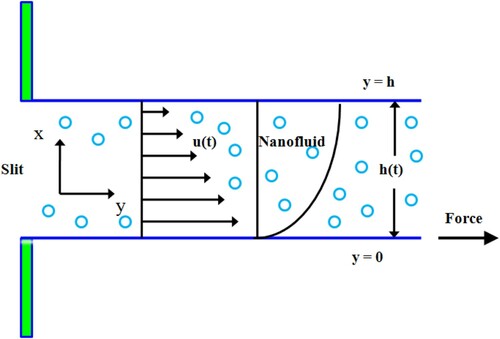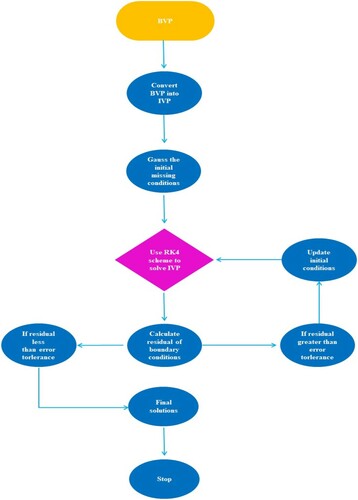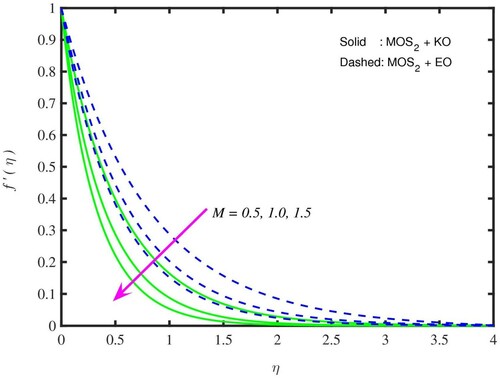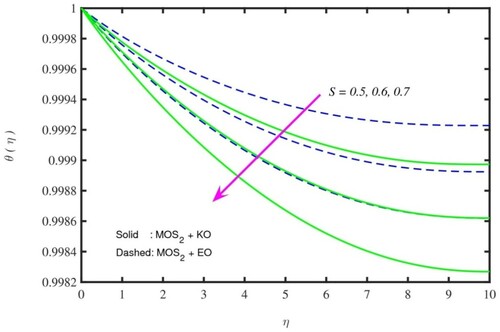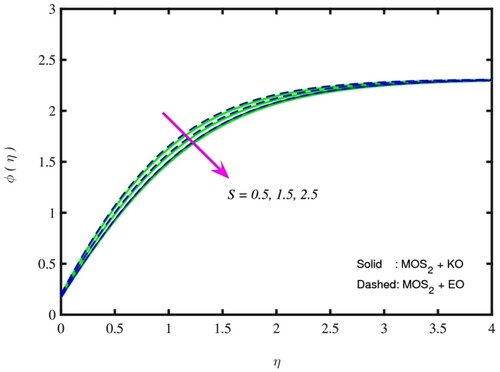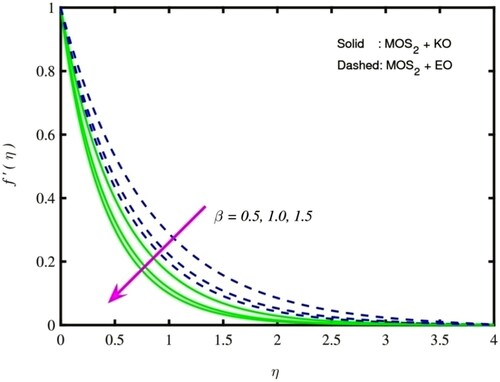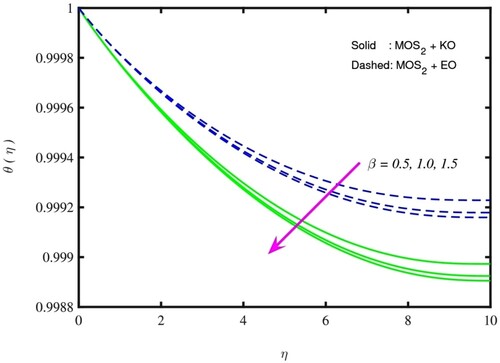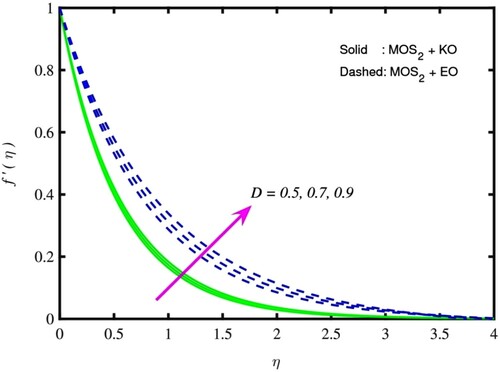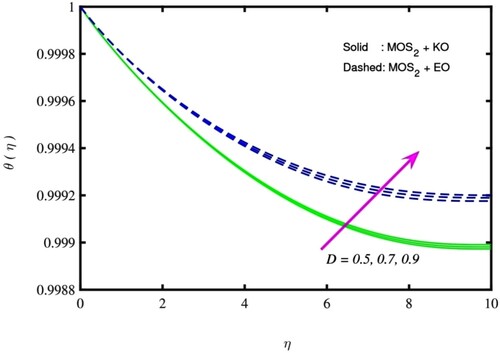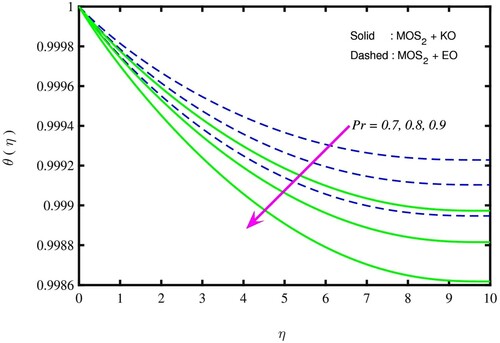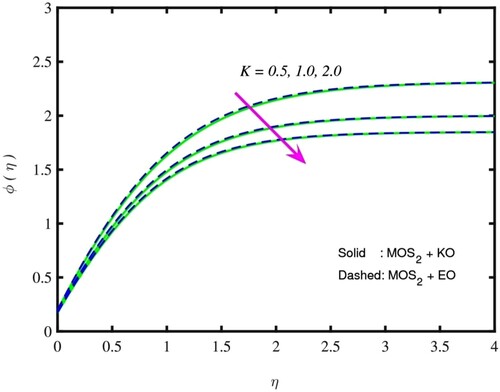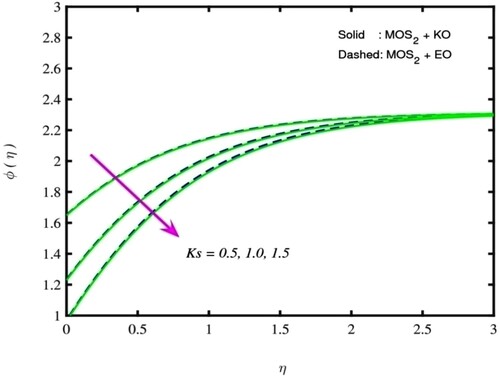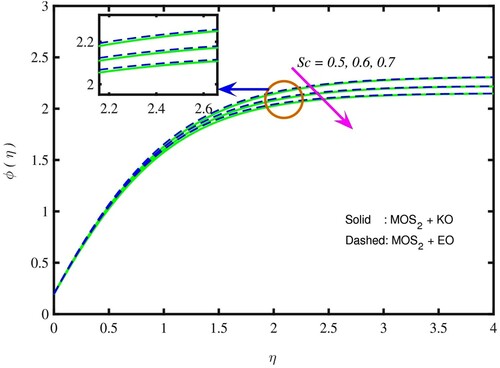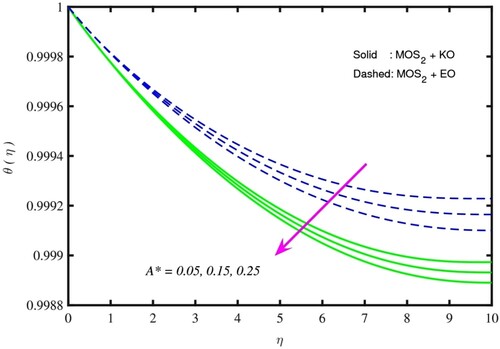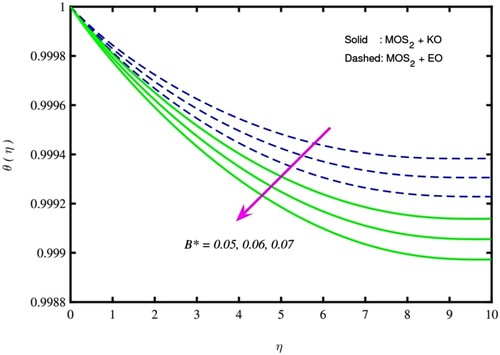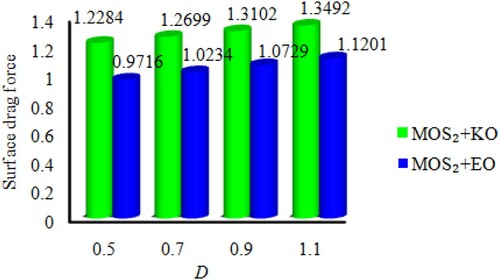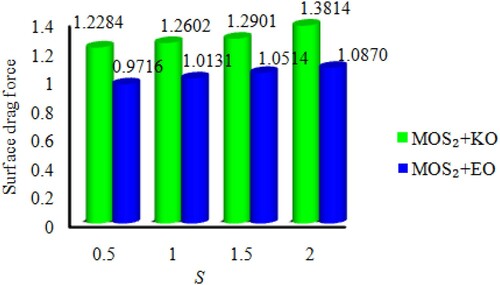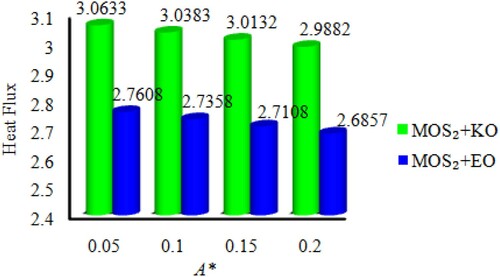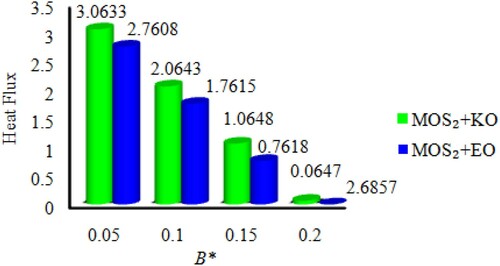 ?Mathematical formulae have been encoded as MathML and are displayed in this HTML version using MathJax in order to improve their display. Uncheck the box to turn MathJax off. This feature requires Javascript. Click on a formula to zoom.
?Mathematical formulae have been encoded as MathML and are displayed in this HTML version using MathJax in order to improve their display. Uncheck the box to turn MathJax off. This feature requires Javascript. Click on a formula to zoom.Abstract
Topical endeavour is made to describe and search out the flow characteristics correspond to nano flow over thin liquid film dispensed with Molybdenum disulphide (MOS2) in a Casson fluid past an unsteady exponentially stretching sheet in porous medium. Due to this problem is modelled to boost the rate of thermal transfer of Diathermic oils, particularly, Kerosene-oil (KO) and Engine-oil (EO) by considering uneven heat source/sink. The governing equations are standardized into a system of ordinary differential equations by means of similarity transformations. The elucidation of the physical problem is conquered by shooting technique. The impact of pertinent parameters on flow and heat transfer is deliberated with the aid of graphs and tables. It is shown that the rate of heat transfer enhances by adding MOS2 in engine oil than MOS2 in kerosene oil, which improves its lubrication properties. The current conclusions are promoted academic research, tribology and polymer industry.
1. Introduction
The problem of heat transmission in a thin liquid film flow on a time-dependent stretching sheet has got many applications in various fields, erratic from a meticulous situation of flow in lungs of human beings to problems in lubrication engineering. Also, its significance can be perceived in films of tear in human’s eye, used as a thin layer in bio-physics, varnish of wire, coating streams and fibre, in industrial developments, and in structural and fluid mechanics. Manufacturing of artificial fibres, crystal growing, food stuff processing, manufacturing of plastic fluid and in aerodynamics, and constant casting, rolling and tinning of copper wires are the various renowned uses of liquid films. In the process of extrusion, the extrudate surface quality maintenance is very important. The appearance of the best product should have a smooth surface while coating that requires low friction, strength and transparency. In extrusion processes, the quality of product mainly depends on the momentum and heat transfer of a slender liquid film above a stretched sheet. In the first phase, the study of flow on liquid film was restricted to viscous fluids, later was extended to non-Newtonian fluid.
The thin-film flow on a slendering sheet was first discussed by Wang [Citation1]. In addition, Wang’s work was developed by Andersson et al. [Citation2,Citation3] by taking into account the power-law fluid for various physical properties. Furthermore, heat transfer flow on the thin film over a slendering sheet was discussed by many researchers [Citation4–6].
Quadratic, linear, non-linear and exponential varying of stretching velocity and temperature are considered by many investigators. But Magyari and Keller [Citation7] investigated a slendering sheet with exponential changing of velocity on the flow and thermal boundary layers. Consequently, the flow problems generated by an exponentially stretching surface have been created [Citation8–11].
Heat transfer can be enhanced by dispersing nanodimensioned particles into a conventional fluid and it has got extensive enactment in industries and engineering. The stability of nanofluids lasts for a long period of time. Convective heat transport feature of nanofluids depends on the model of the problem, the shapes of nanoparticle and the volume fraction of the nanoparticles [Citation12]. Electronic gadgets, biomedicine, transportation, lubrication and laser are some of the applications.
Besides water-based nanofluids, oil-based nanofluids have significance in many industrial fields with elevated thermal conductivity. Diathermic oils are used in renewable energy systems. It is mostly used at high temperatures or where water and vapour are not favourable to use. As a result, using nanoparticles, thermo-physical properties of diathermic oil can be improved to increase the execution of the systems. The cooling of jet and rockets is a tough part for mechanical and avionics engineers.
Owing to this, a problem is modelled using diathermic oils, particularly, kerosene oil (KO) and engine oil (EO). In various operating machine systems, more heat is produced while in running as a result of frictional forces, and the machine components are unable to continue the functioning and stop working earlier. To decrease the friction inside the machine parts, different lubricants are used for lubrication purpose and for cleaning of the engine. EO takes a dynamic part in the working of machine and acts as blood for the vehicles. The thermal conductivities of lubricants can be enhanced by adding nanoparticles in oils and greases by which the period of time of operations of machine bearings can be enhanced. Kerosene is used as a fuel in semi-cryogenic engine as a regenerative coolant.
Magnetohydrodynamics (MHD) is the analysis of electrically conducting fluids. MHD has major applications in industry and engineering as in MHD sensors, growth of crystals, reactor cooling, geophysics, prediction of climate and so on. In MRI, magnetic drug targeting, cancer treatment, magneto-nanoparticles are widely used. Some motivative works on nanofluids with magneto-nanoparticles can be found in the previous studies [Citation13–22].
The analysis of flow-through porous materials such as soil, bones, aquifers, wood, sand, oil reservoirs and others play a significant role in engineering, oil recovery, ground water hydrology, medicine, ignition of coal, growth of warmness pipeline, misappropriation of scattering matter underground. The characteristics of boundary and inertia are included in the non-Darcian porous surface, which is an improved form of the normal Darcy theory. Many researchers with different approaches have been investigated in the previous studies [Citation23–32].
Molybdenum disulphide (MOS2) is a compound containing alternatively arranged molybdenum and sulphur atoms, and sorted as a metal dichalcogenide semiconductor. It occurs as a solid mineral named molybdenite which is in silvery black colour. As it has little frictional property and robustness, it is broadly used as a solid lubricant and catalyst. It has unique possessions such as high carrier mobility, chemical inertness, photoconductivity, anisotropy, environmental sensitivity, mechanical properties and photo corrosion resistance. Furthermore, MOS2 materials possess abnormal wetting behaviour, as that of graphene. Dilute acids and oxygen cannot affect MOS2. MOS2 nanofluids are water-based fluids dispensed with nanosized particles of MOS2. The MOS2 nanoparticles reduce the heat generated in the grinding parts of the machine. Zhang et al. [Citation33] experimentally prepared a Newtonian molybdenum disulphide nanofluid which is homogenously stable and has solo and multilayer sheets with huge band gap structure. In logic circuits and devices with amplifier (Das et al. [Citation34] and Dankert et al. [Citation35]) and also in 2D electronic devices (for example, field effect transistors), MOS2 is widely used because of its unique structure. Moreover, MOS2 is used in many mechanical applications [Citation36–38] because of its lubrication ability. With the above-mentioned properties, the materials are used for the parting and absorption of oil and some organic toxins from water. A few challenges on nanofluids with MOS2 are completed by Ilyas Khan [Citation39], Gul et al. [Citation40] and Liu et al. [Citation41].
In heat transfer analysis, heat generation or absorption enacts a foremost role in amending the heat transfer in the boundary. Temperature assimilations are noticed within the boundary layer by applying heat source/sink, and consequently affects the deposition rate of the particles in the system as in nuclear reactors, electronic chips and semiconductor wafers and so on. The temperature distribution can be modified by producing heat in the fluid, as a result, the particle deposition rate is affected. A like studies have different applications in modelling of biomedical instruments. In this study, uneven heat source/sink is considered. Studies related to the above effect have been exemplified in the previous studies [Citation42–48].
Fluids in nature are categorized based on their viscosity into the following two types: Newtonian and non-Newtonian. The shear stress is linear to the shear rate, in the absence of yield stress for Newtonian fluids. H2O, low-concentrated motor oil, alcohol and air are common Newtonian fluids. Most of the fluids in nature are not Newtonian, that is, their viscous nature alters with strain rate, which results uncertainty in viscosity. Non-Newtonian fluid examples include soaps in liquid form and cosmetics, lubricants, wall paints, toothpastes, slurries, gels, foods, for instance, jam, butter, cheese, mayonnaise and soups, materials in nature, for example, lava, magma and petroleum, and also blood, saliva and synovial fluid (articulation fluid) which are biological fluids and a few types of diffusions. While modelling a non-Newtonian fluid model, highly non-linear terms are produced in governing differential equations. Hence, different fluid models are proposed like Maxwell model, Bingham Herschel-Bulkley, Williamson model, Eyring model, Rivlin Ericksen, Sisko model, Carreau model and so on.
Among these models, Casson model is a real and generally treated fluid model which shows yield stress pseudo plastic properties, and are practically used in bio field, polymer processing and in extraction of crude oil, manufacture of plastic materials. For these fluids, viscosity and heat conductivity are linear with the temperature. Physically, the Casson is a shear-thinning liquid, but it appears as a solid when yield stress is even more when compared with the applied shear stress. It starts to move about when yield stress is below the shear stress. Casson first introduced this model on a flow of printing ink for pigment oil-suspensions in his work. The commonly used Casson fluids are honey, tomato sauce and some jellies. Casson fluid is well supportive in modelling of blood oxygenators and dialysis as it narrates the properties of the blood flow smartly. At low shear rate, if blood flows through small vessels, then it is expressed by Casson fluid flow model.
Homogeneous and heterogeneous actions take place in several processes like explosions, catalysis and structures in biochemistry. The reactions which take place at two or more stages on the surfaces are heterogeneous and come about at the same phase in the fluid are homogeneous. Iron oxidation, outburst of fireworks, metabolism of foodstuff in body, dispersion and manufacturing of ceramics and polymers are some of the appliances of reactions. The initial studies on the chemical reactions are made by Merkin [Citation49]. This has shown the way for many investigators (Reddy and Suneetha [Citation50], Rana et al. [Citation51], Reddy et al. [Citation52]) to spot lights on such types of actions.
Motivated from the above works, an attempt has been made on the diathermic oils ((EO) and (KO)) as the base fluids over a liquid thin film implanted in a porous medium. The fluid is electrically conducting and MOS2 nanoparticle of tubical shape is suspended in two base fluids. The problem is modelled using RK4S approach – bvp4c codes in MATLAB. Of particular attention in this work is to inspect and review the solutions of the partial differential equations, which are non-linear using the shooting method. Obtained outcomes are displayed with graphs and tables. Diathermic oils are vastly used in temperature-controlling processes.
2. Formulation
In this research, it is assumed that a 2D porous nanoliquid film of magnetohydrodynamic Casson nanofluid past an unsteady exponentially stretching sheet. In this work, MOS2 is treated as base nanoparticle. A fine slot is arranged at the initiating point of a system Here, x-axis indicates the sheet-stretching direction with velocity
wherein c and
are invariable so as to facilitate positive c denotes the rate of stretching and
The stretching surface is upright to y-axis. A magnetic field
is applied vertically to sheet externally, as shown in . The sheet thermal profile is designed as
where
represents the kinematic viscosity wherein “f” designates the base fluid.
A** and B** are the two species taken in the boundary layer flow for homogeneous (or bulk) and heterogeneous (on sheet) chemical reactions
where kc (rate constant) and ks (rate constant) and a, b are the concentrations of the chemical species
and
. The reactions are assumed isothermal for both processes.
A different kind of non-Newtonian fluid utilized by Casson in his study known as Casson fluid has a unique feature that it acts as an elastic solid.
The rheological equation of state for an isotropic and incompressible flow of a Casson fluid can be written as (BalaAnki Reddy and Suneetha [Citation52] and Jasmine et al. [Citation53])
when
Casson fluid (non-Newtonian) flow
when
is the non-Newtonian fluid yield stress,
is the dynamic viscosity of the fluid,
where eij is the deformation rate in
component and
is the critical value stands on the non-Newtonian model.
Casson parameter β and plastic dynamic viscosity μb are important on which the kinematics viscosity of Casson fluid depends. The graph between µb and thermal conductivity κ is a straight line with temperature. The fluid molecules wield attraction forces on one another. This attracting power is strong in liquids to preserve the mass collectively when compared with the solids. Casson fluid when exposed, conduct heat and shows shear thinning properties. For lubricating fluids, the viscosity of the fluid cannot be constant; it changes with the heat generated by the internal friction resulting in enhanced temperature and affects the fluid viscosity. The fluids in industrial systems are subjected to high temperatures, pressure, high shear rates, and heating from outside, which leads to more temperature being produced within the fluid.
The fluid flow under the above attentions can be placed into the form (Sulochana et al. [Citation54] Raees [Citation55])
(1)
(1)
(2)
(2)
(3)
(3)
(4)
(4)
(5)
(5)
Subject to the boundary conditions (Sulochana et al. [Citation54], Vijaya et al. [Citation56] and Fakour [Citation57])
(6)
(6)
H(t): thickness of the fluid film
(7)
(7)
The heat source/sink “” designates by
where A* and B* are parameters of space-dependent and temperature-dependent internal heat generation/absorption. It is to be noted that A* > 0 and B* > 0 correspond to internal heat generation while A* < 0 and B* < 0 correspond to internal heat absorption.
Table I. Reveal the numerical values of base fluids and nanoparticles [Citation58].
Practically, nanoparticle concentration of MOS2 is little. The nanofluid constants are
Where
(8)
(8)
Launching the dimensionless variables as
(9)
(9)
Adopting Equations (8) and (9) in Equations (1)–(5), we have
(10)
(10)
(11)
(11)
(12)
(12)
(13)
(13)
at
(14)
(14)
at
(15)
(15)
where
Thus, for the coefficient of diffusions
and
are identical
(16)
(16)
Equations (12) and (13) under this assumption reduced to
(17)
(17)
associated boundary conditions
The surface drag force, and local Nusselt are
(18)
(18)
Where and
are given at y = 0 as
(19)
(19)
In view of Equations (9) and (19) in Equation (18), we acquire
(20)
(20)
where
3. Numerical scheme
The PDEs of this model are renovated into ODEs after employing proper transformation. But Equations (10), (11) and (17) are nonlinear and tough to get their analytical solutions. So, solve it numerically by shooting technique with RK4-method (see ). The system of ODEs which are not linear are converted into differential equations of first order as given below
Correlated boundary conditions are
This procedure is used for boundary layer flow problems. Introduce initial guesses to and
to get approximate solution by assuming the size of the step as 0.001 and the criteria for all cases to converge is 10−6.
4. Validation of numerical method
To decide the meticulousness of the numerical method, we have executed an assessment for the values of heat flux and with M = A* = B* = D = 0, against S with those of Sulochana et al. [Citation54]. Our outcomes are in a good deal with Sulochana et al. [Citation54], as demonstrated in .
Table II. Comparison of the present results for when
and
Ali et al. [Citation59] experimentally shown the outcome of MOS2 nanoparticles in EO and concluded that the frequency rate of heat transfer could be improved up to 6.35%. Ali et al. [Citation58] scrutinized in Brinkman-type nanofluid with the sculpt impact of MOS2 nanoparticles in EO and revealed that the heat flux is increased to 13.51% which improves the lubrication properties.
5. Results proclamation
In this segment, figures are captivated for the parameters involved in the flow region. The calculations have been done numerically by assuming the default values
and
until otherwise specified particularly. Here, we examined the following two cases: MOS2+KO and MOS2+EO.
The impact of magnetic flux parameter on momentum and thermal fields of MOS2 nanofluid is examined for both the base fluids KO and EO and provided in Figures and . It can be known from the figure that when a magnetic field is applied in an electrically conducting Casson fluid, it generates an opposing force named as Lorentz force. Both the momentum and thermal boundary layers are declined by this force. Physically, the magnetic parameter is linked with the Lorentz force which is a resistive force to the fluid flow. An enhancement in magnetic parameter provides more resistive force and as a result velocity diminishes. It is observed from that M and temperature distribution are inversely proportional to each other. This is because the growth in Hartmann number raises the magnetic force, results in the expansion of the magnetic field strength which deprecate the convective heat transfer process. For greater magnetic field strength, the convection effect is declined. Thus, the fluid motion demotes resulting conduction as the leading heat transfer mechanism. It is also pragmatic that MOS2 + KO is very much influenced by the resistive type force when correlated with MOS2 + EO.
The upshot of on flow, thermal and mass areas is displayed in Figures , and . It is reported from the figures that the appreciating values of S downgrade the momentum, thermal and species fields for both the cases. Also, it is noticed that the effect of MOS2 + KO is more on the thermal and momentum boundary layer than on the concentration boundary layer. This abides the general physical nature, that is, mounting values of
condense the effect of buoyancy on the flow. This decreases the thermal, momentum and concentration boundary layer.
Figures and show the graphical aspects of the disparity of velocity and temperature allotment for diverse values of the Casson parameter . Casson fluid velocity declines near the wall and negligibly decreases far from the vertical wall when β enhances. shows that the velocity shrinks with swelling values of
, that is, the declining yield stress (when Casson parameter raises the fluid behaves as Newtonian fluid) matches up to the viscosity and rate of deformation. The boundary layer thickness contracts due to the presence of tensile stress caused by the elasticity. It is evident from the sketch that when we upsurge β indefinitely, the present situation reduces to the case of Newtonian fluid, the velocity subsides significantly within a layer near the vertical wall. Hence, the magnitude of the velocity is more in Casson fluid when related to viscous fluids. From , it is inferred that the thermal boundary layer width and
are inversely proportional. The diminution is pronounced for lower β compared to higher β. However, the situation with β tends to increase implicating the nature of temperature field line of the Newtonian fluids. The decrement in velocity and temperature for MOS2+KO is more than MOS2+EO.
brings to light about the velocity deviation for porous medium for thin nanofluid film. The porous media parameter indicates the absorption rate of the fluid when passing through pores. By enlarging D, the resistance among the pores and moving liquid shrinks, consequently, the velocity escalates. This signifies that when the fluid passes through the porous medium, fluid transfers with higher velocity. As porosity grows, fraction forces decline between the fluids and the medium resulting the velocity of the fluid to proliferate. From the draft, it is noticed that a growth in
enhances the velocity. The increment in
should be very little as the width of the film is small, towering values of
that is,
match to non-porous medium. The up warding
responds to the huge gap of the porous opening, which lessen the hindrance of the flow for
and the velocity rises. The dimensionless temperature profile is shown in for different values of
and noticed that with an increase in
the temperature increases.
In the thermal variations for different are shown. It is noted that the temperature and
are inversely proportional for both the cases. Prandtl number is a fraction of kinematic viscosity to thermal diffusivity. Therefore, for advanced values of Prandtl number, the thermal diffusivity reduces. Physically, Pr is the ratio of momentum diffusion to thermal diffusion. A fluid with large
have large heat capacity, and therefore the heat transfer increases. That is,
reduces the temperature distribution due to the raise in heat transfer ability of flow fluid as the Pr enhances. As Pr increases, thermal diffusion drops and the thermal boundary layer becomes thinner. It gives the data about the fluid type, and also thickness of hydrodynamic and thermal boundary layers. The Pr number implies numerous computations of heat transfer in fluid metal reactors. Generally,
is used in heat transfer problems that figure out the relative coagulate of the momentum and the thermal boundary layers. Also, the reduction in temperature is more in MOS2+ KO than MOS2+ EO.
Profiles of non-dimensional concentration are plotted in Figures and for homogeneous and heterogeneous reactions on the species distribution. As the values of
and
mounted, a decrement in concentration is inferred from the figures. If the strengths of homogeneous and heterogeneous actions are raised, the consumption of chemical reactants also raised which results in a fall in the concentration.
displays the effect of on concentration. The mass momentum transmission is stated as Schmidt number. Sc is used to describe the fluid flow where contemporaneous momentum and mass diffusion convection occur. Schmidt number is a dimensionless number defined as the ratio of momentum diffusivity and mass diffusivity. Figure shows a decrement in the concentration as
raises. This is because of the strong diffusion species have higher retarding effect on the concentration. In many heat transfer procedures, Schmidt and Prandtl numbers are related with each other. Sc is a main tool for thermal and chemical engineers, for developing gas turbine and also in jet flows.
shows fed light on the influence of space-dependent heat source/sink parameter A* on temperature distribution. If A* > 0 (heat source), the boundary layer produces energy, which in turn enhances the fluid temperature. If A* < 0 (absorption), the boundary layer absorbs energy, which results in a fall in the temperature. The influence of B* on temperature profile is shown in . It is inferred that the temperature raises as energy is released into the fluid when B* > 0 and a destructive trend is observed for B* < 0, that is, a drop in temperature is noticed as the energy is observed by the fluid.
exemplifies the disparity in surface drag force for various It is noted that an increment of
increases the surface drag force for MOS2+KO and MOS2+EO. The outcome of
on surface drag force is verified in . It uncovers that growing values of
grow the surface drag force for both cases.
exemplifies the effect of heat flux on . Figure illustrates that a growth in
has a drop in the heat flux for the two cases. The effect of
on heat flux is defined in . It is revealed that mounting of
falls down the heat flux for both cases. The increment for MOS2+EO is more than MOS2+KO. exemplifies the effect of heat flux on
The outcomes show that a rise in
raises the heat flux for both cases.
describes the deviations of surface drag force for different values of and
. The surface drag force accelerates with
and
and decelerates with
.
Table III. The values of surface drag force and various dimensionless parameters.
exhibits the difference in heat flux for diverse values of , and
. Declination in heat flux for
and
is noted, whereas inclination for
and
is observed.
Table IV. Deviations in the heat flux and various dimensionless parameters.
6. Conclusions
Investigation of the flow features imparted to viscous fluid flow over thin liquid film dispensed with molybdenum disulphide (MOS2) in a Casson nanofluid past an unsteady exponentially stretching sheet with a porous medium is done in this section. Diathermic oils with MOS2 nanoparticles reduce the friction among the moving parts of the machine. It also reduces the heat generation caused by the frictional forces. It finds a notable use in mechanics, industrial and engineering fields. The PDEs are renewed into non-linear ODEs by transformations and then disclosed numerically by RK4S method. The numerical outcomes are portrayed in graphs and tables. The concluding statements are as follows:
Cutback in
for elevated Pr and
enhances the velocity.
The velocity, thermal and species are inversely proportional to the unsteadiness parameter for both cases.
The escalating values of
, reaction rate parameter,
and
, concentration drops.
are inversely proportional to the heat flux. Also, the increment for MOS2+EO is more than MOS2 + KO.
The surface drag force and the heat flux are high for large values of the porosity parameter and Pr.
Abbreviations
| = | applied magnetic field strength (A/m) | |
| = | dimensionless parameter | |
| = | dimensionless velocity | |
| = | engine oil | |
| = | film size (m) | |
| = | (i, j)th component of the deformation rate | |
| = | heat flux from the surface (W m−2) | |
| = | heterogeneous reaction strength | |
| = | homogeneous reaction strength | |
| = | initial stretching velocity along y-axis (m s−1) | |
| = | initial temperature of the fluid (K) | |
| = | initial stretching velocity along x-axis (m s−1) | |
| = | kerosene oil | |
| = | local Nusselt number | |
| = | surface drag force | |
| = | local Reynolds number | |
| = | magnetic field parameter | |
| = | porosity parameter | |
| = | pressure (kg m−1 s−2) | |
| = | Prandtl number | |
| = | reference temperature of the fluid (K) | |
| = | Schmidt number | |
| = | specific heat at constant pressure (J kg−1 K−1) | |
| = | stretching rate (s−1) | |
| = | time (s) | |
| = | surface temperature of the fluid (K) | |
| = | temperature (K) | |
| = | thermal conductivity (m2 s−1) | |
| k* | = | permeability of porous medium |
| = | unsteadiness parameter | |
| = | velocity component along x-axis (m s−1) | |
| = | velocity component along y-axis (m s−1) | |
| = | wall temperature of the fluid (K) | |
| = | x-axis coordinate (m) | |
| = | y-axis coordinate (m) |
Greek symbols
| = | Casson fluid parameter | |
| = | constant (s−1) | |
| = | critical value of the product of the deformation rate with itself | |
| = | density (kg m−3) | |
| = | dimensionless fluid thickness parameter | |
| = | dimensionless temperature | |
| = | electrical conductivity | |
| = | kinematic viscosity (m2 s−1) | |
| = | nanofluids constants | |
| = | physical stream function (m2 s−1) | |
| = | plastic dynamic viscosity of the Casson fluid | |
| = | shear stress at the surface (kg m−1 s−2) | |
| = | shear stress of Casson fluid along (i, j)th component (kg m−1 s−2) | |
| = | ratio of diffusion coefficient | |
| = | similarity variable | |
| = | volume fraction of the MOS2 nanoparticles |
Subscripts
| = | base fluid | |
| = | fluid properties at ambient condition | |
| = | solid nanoparticles | |
| = | surface | |
| = | nanofluid |
Disclosure statement
No potential conflict of interest was reported by the author(s).
References
- Wang CY. Liquid film on an unsteady stretching surface. Q Appl Math. 1990;48:601–610. doi:https://doi.org/10.1090/qam/1079908.
- Andersson I, Aarseth B, Braud N. Flow of a power-law fluid film on an unsteady stretching surface. J Nonnewton Fluid Mech. 1996;62:1–8. doi:https://doi.org/10.1016/0377-0257(95)01392-X.
- Andersson HI, Aarseth JB, Dandapat BS. Heat transfer in a liquid film on an unsteady stretching surface. Int J Heat Mass Transf. 2000;43:69–74. doi:https://doi.org/10.1016/S0017-9310(99)00123-4.
- Sandeep N, Malvandi A. Enhanced heat transfer in liquid thin film flow of non-Newtonian nanofluids embedded with graphene nanoparticles. Adv Powder Technol. 2016;27:2448–2456. doi:https://doi.org/10.1016/j.apt.2016.08.023.
- Qasim M, Khan ZH, Lopez RJ, et al. Heat and mass transfer in nanofluid thin film over an unsteady stretching sheet using Buongiorno ‘ s model. Eur Phys J Plus. 2016;131:1–11. doi:https://doi.org/10.1140/epjp/i2016-16016-8.
- Zuhra S, Khan NS, Khan MA, et al. Flow and heat transfer in water based liquid film fluids dispensed with graphene nanoparticles. Results Phys. 2018;8:1143–1157. doi:https://doi.org/10.1016/j.rinp.2018.01.032.
- Magyari E, Keller B. Heat and mass transfer in the boundary layers on an exponentially stretching continuous surface. J Phys D Appl Phys. 1999;32:577–585. doi:https://doi.org/10.1088/0022-3727/32/5/012.
- Tantry IA, Wani S, Agrawal B. Study of MHD boundary layer flow of a casson fluid due to an exponentially stretching sheet with radiation effect. Int J Stat Appl Math. 2021;6:138–144.
- Nagaraja B, Gireesha BJ. Exponential space-dependent heat generation impact on MHD convective flow of Casson fluid over a curved stretching sheet with chemical reaction. J Therm Anal Calorim. 2021;143:4071–4079. doi:https://doi.org/10.1007/s10973-020-09360-0.
- Janareddy S, Valsamy P, Srinivasreddy D. Radiation and heat source/sink effects on MHD Casson fluid flow over a stretching sheet with slip conditions. J Math Comput Sci. 2021;11:6541–6556. doi:https://doi.org/10.28919/jmcs/6385.
- Aloliga G, Ibrahim Seini Y, Musah R. Heat transfer in a magnetohydrodynamic boundary layer flow of a non-newtonian casson fluid over an exponentially stretching magnetized surface. J Nanofluids. 2021;10:172–185. doi:https://doi.org/10.1166/jon.2021.1777.
- Kumar S, Prasad SK, Banerjee J. Analysis of flow and thermal field in nanofluid using a single phase thermal dispersion model. Appl Math Model. 2010;34:573–592. doi:https://doi.org/10.1016/j.apm.2009.06.026.
- Ahmad F, Gul T, Khan I, et al. MHD thin film flow of the Oldroyd-B fluid together with bioconvection and activation energy. Case Stud Therm Eng. 2021;27:101218. doi:https://doi.org/10.1016/j.csite.2021.101218.
- Guled CN, Tawade JV, Priyanka P. The MHD flow of liquid film in the presence of dissipation and thermal radiation through an unsteady stretching sheet by HAM. Turkish J Comput Math Educ. 2021;12:949–959.
- Gul T, Rehman M, Saeed A, et al. Magnetohydrodynamic impact on Carreau thin film couple stress nanofluid flow over an unsteady stretching sheet. Math. Probl. Eng. 2021;2021:1–10. doi:https://doi.org/10.1155/2021/8003805.
- Ilyana Kamis N, Md Basir MF, Shafie S, et al. Suction effect on an unsteady Casson hybrid nanofluid film past a stretching sheet with heat transfer analysis. IOP Conf. Ser. Mater. Sci. Eng. 2021;1078:012019), doi:https://doi.org/10.1088/1757-899x/1078/1/012019.
- Varun Kumar RS, Gunderi Dhananjaya P, Naveen Kumar R, et al. Modeling and theoretical investigation on Casson nanofluid flow over a curved stretching surface with the influence of magnetic field and chemical reaction. Int J Comput Methods Eng Sci Mech. 2021;0:1–8. doi:https://doi.org/10.1080/15502287.2021.1900451.
- Tlili I, Samrat SP, Sandeep N. A computational frame work on magnetohydrodynamic dissipative flow over a stretched region with cross diffusion: simultaneous solutions. Alexandria Eng J. 2021;60:3143–3152. doi:https://doi.org/10.1016/j.aej.2021.01.052.
- Tlili I, Samrat SP, Sandeep N, et al. Effect of nanoparticle shape on unsteady liquid film flow of MHD Oldroyd-B ferrofluid. Ain Shams Eng J. 2021;12:935–941. doi:https://doi.org/10.1016/j.asej.2020.06.007.
- Imran M, Farooq U, Waqas H, et al. Numerical performance of thermal conductivity in bioconvection flow of cross nanofluid containing swimming microorganisms over a cylinder with melting phenomenon. Case Stud Therm Eng. 2021;26:101181. doi:https://doi.org/10.1016/j.csite.2021.101181.
- Arain MB, Bhatti MM, Zeeshan A, et al. Bioconvection reiner-rivlin nanofluid flow between rotating circular plates with induced magnetic effects, activation energy and squeezing phenomena. Mathematics. 2021;9:1–30. doi:https://doi.org/10.3390/math9172139.
- Abo-Elkhair RE, Bhatti MM, Mekheimer KS. Magnetic force effects on peristaltic transport of hybrid bio-nanofluid (Au–Cu nanoparticles) with moderate Reynolds number: An expanding horizon. Int Commun Heat Mass Transf. 2021;123:105228), doi:https://doi.org/10.1016/j.icheatmasstransfer.2021.105228.
- Ishaq M, Ali G, Shah SIA, et al. Nanofluid film flow of eyring Powell fluid with magneto hydrodynamic effect on unsteady porous stretching sheet. J Math. 2019;51:147–169.
- Farooq U, Hussain M, Ijaz MA, et al. Impact of non-similar modeling on Darcy-Forchheimer-Brinkman model for forced convection of Casson nano-fluid in non-Darcy porous media. Int Commun Heat Mass Transf. 2021;125:105312), doi:https://doi.org/10.1016/j.icheatmasstransfer.2021.105312.
- Abo-Dahab SM, Abdelhafez MA, Mebarek-Oudina F, et al. MHD Casson nanofluid flow over nonlinearly heated porous medium in presence of extending surface effect with suction/injection. Indian J Phys. 2021. doi:https://doi.org/10.1007/s12648-020-01923-z.
- Al-Mamun A, Arifuzzaman SM, Reza-E-Rabbi S, et al. Numerical simulation of periodic MHD casson nanofluid flow through porous stretching sheet. SN Appl Sci. 2021;3:1–14. doi:https://doi.org/10.1007/s42452-021-04140-3.
- Alhadhrami A, Vishalakshi CS, Prasanna BM, et al. Numerical simulation of local thermal non-equilibrium effects on the flow and heat transfer of non-Newtonian Casson fluid in a porous media. Case Stud Therm Eng. 2021;28:101483), doi:https://doi.org/10.1016/j.csite.2021.101483.
- Venkata Subba Rao M, Gangadhar K, Sobhana Babu PR. Sutterby fluid flow past a stretching sheet embedded in a porous media with viscous dissipation. Int J Ambient Energy. 2021. doi:https://doi.org/10.1080/01430750.2021.1945491.
- Anwar T, Kumam P, Watthayu W. Unsteady MHD natural convection flow of Casson fluid incorporating thermal radiative flux and heat injection/suction mechanism under variable wall conditions. Sci Rep. 2021;11:1–15. doi:https://doi.org/10.1038/s41598-021-83691-2.
- Waqas H, Farooq U, Khan SA, et al. Numerical analysis of dual variable of conductivity in bioconvection flow of Carreau–Yasuda nanofluid containing gyrotactic motile microorganisms over a porous medium. J Therm Anal Calorim. 2021;145:2033–2044. doi:https://doi.org/10.1007/s10973-021-10859-3.
- Maleki H, Safaei MR, Alrashed AAAA, et al. Flow and heat transfer in non-Newtonian nanofluids over porous surfaces. J Therm Anal Calorim. 2019;135:1655–1666. doi:https://doi.org/10.1007/s10973-018-7277-9.
- Maleki H, Alsarraf J, Moghanizadeh A, et al. Heat transfer and nanofluid flow over a porous plate with radiation and slip boundary conditions. J Cent South Univ. 2019;26:1099–1115. doi:https://doi.org/10.1007/s11771-019-4074-y.
- Zhang Y, Gu S, Yan B, et al. Solvent-free ionic molybdenum disulphide (MoS2) nanofluid. J Mater Chem. 2012;22:14843–14846. doi:https://doi.org/10.1039/c2jm33106c.
- Das S, Chen HY, Penumatcha AV, et al. High performance multilayer MoS2 transistors with scandium contacts. Nano Lett. 2013;13:100–105. doi:https://doi.org/10.1021/nl303583v.
- Dankert A, Langouche L, Kamalakar MV, et al. High-performance molybdenum disulfide field-effect transistors with spin tunnel contacts. ACS Nano. 2014;8:476–482.
- Gu S, Zhang Y, Yan B. Solvent-free ionic molybdenum disulfide (MoS2) nanofluids with self-healing lubricating behaviors. Mater Lett. 2013;97:169–172. doi:https://doi.org/10.1016/j.matlet.2013.01.058.
- Kato H, Takama M, Iwai Y, et al. Wear and mechanical properties of sintered copper – tin composites containing graphite or molybdenum disulfide. Wear. 2003;255:573–578. doi:https://doi.org/10.1016/S0043-1648(03)00072-3.
- Mao C, Huang Y, Zhou X. The tribological properties of nanofluid used in minimum quantity lubrication grinding. Int J AdvManuf Technol. 2014;71:1221–1228. doi:https://doi.org/10.1007/s00170-013-5576-7.
- Khan I. Shape effects of MoS2 nanoparticles on MHD slip flow of molybdenum disulphide nanofluid in a porous medium ilyas. J Mol Liq. 2017;233:442–451. doi:https://doi.org/10.1016/j.molliq.2017.03.009.
- Gul A, Khan I, Makhanov SS. Entropy generation in a mixed convection Poiseuille flow of molybdenum disulphide Jeffrey nanofluid. Results Phys. 2018;9:947–954. doi:https://doi.org/10.1016/j.rinp.2018.03.012.
- Liu J, Choi G, Cahill DG, et al. Measurement of the anisotropic thermal conductivity of molybdenum disulfide by the time-resolved magneto-optic Kerr effect measurement of the anisotropic thermal conductivity of molybdenum disulfide by the time-resolved magneto-optic Kerr effect. J Appl Phys. 2014;116; doi:https://doi.org/10.1063/1.4904513.
- Sagheer M, Bilal M, Hussain S, et al. Thermally radiative rotating magneto-nanofluid flow over an exponential sheet with heat generation and viscous dissipation : a comparative study thermally radiative rotating magneto-nanofluid flow over an exponential sheet with heat generation and viscous. Commun Theor Phys. Pap. 2018;69:317–328. doi:https://doi.org/10.1088/0253-6102/69/3/317.
- Giri SS, Das K, Kundu PK. Inclined magnetic field effects on unsteady nanofluid flow and heat transfer in a finite thin film with non-uniform heat source / sink. Multidiscip Model Mater Struct. 2018;15:265–282. doi:https://doi.org/10.1108/MMMS-04-2018-0065.
- Nandkeolyar R, Mahatha BK, Mahato GK. Effect of chemical reaction and heat absorption on MHD nanoliquid flow past a stretching sheet in the presence of a transverse magnetic field. Magnetochemistry. 2018;4:1–14. doi:https://doi.org/10.3390/magnetochemistry4010018.
- Reddy SRR, Bala Anki Reddy P, Suneetha S. Magnetohydro dynamic flow of blood in a permeable inclined stretching surface with viscous dissipation, non-uniform heat source/sink and chemical reaction. Front Heat Mass Transf. 2018;10; doi:https://doi.org/10.5098/hmt.10.22.
- Devi R, Poply V, Manimala M. Effect of aligned magnetic field and inclined outer velocity in Casson fluid flow over a stretching sheet with heat source. J Therm Eng. 2021;7:823–844. doi:https://doi.org/10.18186/thermal.930347.
- Venkateswara Raju K, Durga Prasad P, Raju MC, et al. MHD Casson fluid flow past a stretching sheet with convective boundary and heat source. Lect Notes Mech Eng. 2021: 559–572. doi:https://doi.org/10.1007/978-981-15-4308-1_44.
- Maleki H, Safaei MR, Togun H, et al. Heat transfer and fluid flow of pseudo-plastic nanofluid over a moving permeable plate with viscous dissipation and heat absorption/generation. J Therm Anal Calorim. 2019;135:1643–1654. doi:https://doi.org/10.1007/s10973-018-7559-2.
- Merkin JH. A model for isothermal reactions in boundary-layer flow. Mathl Comput Model. 1996;24:125–136.
- Bala Anki Reddy P, Suneetha S. Effects of homogeneous-heterogeneous chemical reaction and slip velocity on mhd stagnation flow of a micropolar fluid over a permeable stretching/shrinking surface embedded in a porous medium. Front Heat Mass Transf. 2017;8:1–11. doi:https://doi.org/10.5098/hmt.8.24.
- Rana S, Mehmood R, Akbar NS. Mixed convective oblique flow of a Casson fluid with partial slip, internal heating and homogeneous – heterogeneous reactions S. J Mol Liq. 2016;222:1010–1019. doi:https://doi.org/10.1016/j.molliq.2016.07.137.
- Bala Anki Reddy P, Suneetha S. Impact of cattaneo-christov heat flux in the casson fluid flow over a stretching surface with aligned magnetic field and homogeneous – heterogeneous chemical reaction. Front Heat Mass Transf. 2018;10:1–9. doi:https://doi.org/10.5098/hmt.10.7.
- Jasmine Benazir A, Sivaraj R, Makinde OD. Unsteady magnetohydrodynamic casson fluid flow over a vertical cone and flat plate with non-uniform heat source/sink. Int J Eng Res Africa. 2016;21:69–83. doi:https://doi.org/10.4028/www.scientific.net/JERA.21.69.
- Sulochana C, Samrat SP, Sandeep N. Magnetohydrodynamic radiative liquid thin film flow of kerosene based nanofluid with the aligned magnetic field. Alexandria Eng. J. 2018;57:3009–3017. doi:https://doi.org/10.1016/j.aej.2017.11.005.
- Raees A, Wang RZ, Xu H. A homogeneous-heterogeneous model for mixed convection in gravity-driven film flow of nanofluids. Int Commun Heat Mass Transf. 2018;95:19–24. doi:https://doi.org/10.1016/j.icheatmasstransfer.2018.03.015.
- Vijaya N, Sreelakshmi K, Sarojamma G. Effect of magnetic field on the flow and heat transfer in a Casson thin film on an unsteady stretching surface in the presence of viscous and internal heating. Open J Fluid Dyn. 2016;06:303–320. doi:https://doi.org/10.4236/ojfd.2016.64023.
- Fakour M, Rahbari A, Khodabandeh E, et al. Nanofluid thin film flow and heat transfer over an unsteady stretching elastic sheet by LSM. J Mech Sci Technol. 2018;32:177–183. doi:https://doi.org/10.1007/s12206-017-1219-5.
- Ali F, Aamina IK, Sheikh NA, et al. Effects of different shaped nanoparticles on the performance of engine-oil and kerosene-oil: a generalized brinkman-type fluid model with Non-singular kernel. Sci Rep. 2018;8:1–13. doi:https://doi.org/10.1038/s41598-018-33547-z.
- Ali F, Aamina B, Khan I, et al. Magnetohydrodynamic flow of brinkman-type engine oil based MoS2-nanofluid in a rotating disk with Hall effect. Int J Heat Technol. 2017;35:893–902. doi:https://doi.org/10.18280/ijht.350426.

